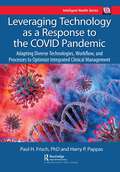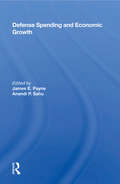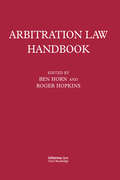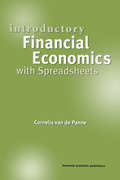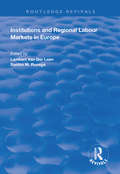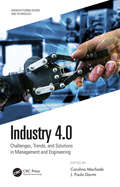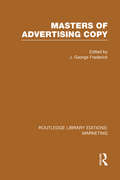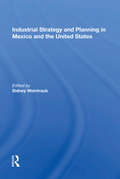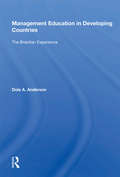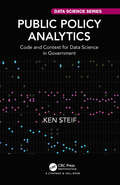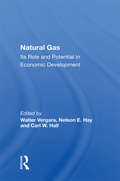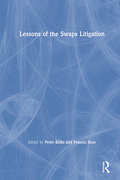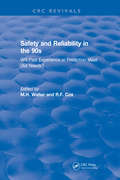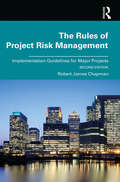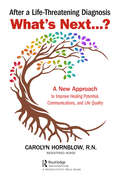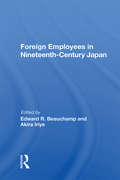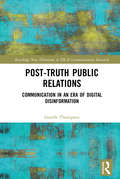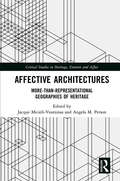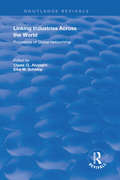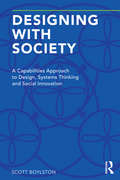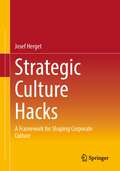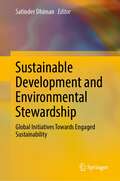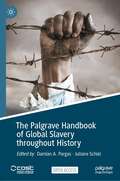- Table View
- List View
Leveraging Technology as a Response to the COVID Pandemic: Adapting Diverse Technologies, Workflow, and Processes to Optimize Integrated Clinical Management (Intelligent Health Series)
by Harry P. Pappas Paul H. FrischIn 2019 the world was struck with the Coronavirus (COVID-19) infecting major portions of the world’s population. There were no vaccines or treatments available to help mitigate the disease or offer a cure. The world's health systems were inundated with massive numbers of patients with varying ranges of symptoms, acuity, and levels of criticality. The world's healthcare organizations soon found themselves in an unmanageable situation, directly impacting the ability to manage patients across the entire healthcare environment. Most healthcare institutions had plans for emergency preparedness and procedures to deal with temporary crises, none of which were effective against the impact of COVID-19. COVID-19 was a highly contagious disease, resulting in high volumes of admissions with long lengths of stay. The virus quickly overwhelmed institutions with large patient volumes, resulting in shortages of patient beds, medical equipment, personal protective devices, cleaning agents, and other critical supplies. Hospital operations were further impacted by staff shortages due to exposure, resulting contagion, the shutdown of transit systems, and responsibilities at home due to school and business closures. This timely and important book describes the impact on the hospital ability to provide patient care and how healthcare institutions leveraged diverse technology solutions to combat the impact of COVID-19 on providing patient care. The authors also discuss implementation of these technology solutions and the many lessons learned of how healthcare institutions can enhance their emergency preparedness in the future from the COVID experience. The authors would like to acknowledge, thank, and dedicate this book to the hundreds of thousands of healthcare workers around the world who spent countless hours and put their own lives and families lives at risk to help patients though this pandemic.
Defense Spending And Economic Growth
by James E. Payne Anandi P. SahuThis book examines the impact defense spending has on economic growth. While defense spending was not deliberately invented as a fiscal policy instrument, its importance in the composition of overall government spending and thus in determining employment is now easily recognized. In light of the collapse of the Soviet Union and the consequent reduction in the threat to the security of the United States, maintaining defense spending at the old level seems indefensible. The media has concentrated on the so-called peace dividend. However, as soon as the federal government is faced with defense cuts, it realizes the macroeconomic ramifications of such a step. Based on studies included in this volume, we examine the effects of defense spending on economic growth and investigate how the changed world political climate is likely to alter the importance and pattern of defense spending both for developed and developing countries.
Arbitration Law Handbook
by Roger Hopkins Benjamin HornThe Arbitration Law Handbook collects together in one volume the laws in force in more than twenty countries, with the main procedural rules used in each of those countries. Each section has a short overview identifying relevant treaty obligations, the main arbitral bodies and the principal laws in force. Additionally, there is an international section in which the UNCITRAL Model Law and Arbitration Rules are set out and in which the major international conventions relating to arbitration, such as the New York Convention and table of signatories, are reproduced. The section also includes the ICSID Arbitration Rules (applicable to the settlement of investment disputes), as well as those of WIPO (applicable to the settlement of intellectual property disputes)
Introductory Financial Economics with Spreadsheets
by Cornelis van de PanneThis text combines the teaching and explanation of spreadsheets with the essentials of finance and economics in a highly-visual, interactive and project-based approach. Students progressively build skills in Microsoft Excel, by proceeding through a variety of basic applications. Users of other spreadsheets will also benefit from the book. This innovative publication includes an accompanying disk that provides the spreadsheet files on which the text is based and the data for the exercises and assignments following each chapter.
Institutions and Regional Labour Markets in Europe (Routledge Revivals)
by Lambert van der Laan and Santos M. RuesgaFirst published in 1998, this volume examines the performance of labour markets against the background of different economic and institutional settings in Western and Eastern Europe. The book gives a clear picture of the mosaic of impressive transformations presently taking place in Western and Eastern European labour markets and provides access to information which was previously either widely dispersed or non-existent. The book gives detailed information about how countries and regions deal with transformations described. The substantive country-wide and regional diversity that is discussed allows the reader to understand the role of labour and institutions in the development of countries and regions. The book is written by labour market and regional experts from the various countries concerned.
Industry 4.0: Challenges, Trends, and Solutions in Management and Engineering (Manufacturing Design and Technology)
by Carolina Machado J. Paulo DavimIndustry 4.0 is a challenge for today’s businesses. It’s a concept that encompasses the technological innovations of automation, control, and information technology, as it’s applied to manufacturing processes. It’s a new topic that recently emerged in academia and industry, with few books that target both management and engineering. This book will cover the new advances and the way to manage competitive organizations. The chapters will include terms of theory, evidence, and/or methodology, and significantly advance social scientific research. This book: Focuses on the latest and most recent research findings occurring on the topic of Industry 4.0 Presents the ways companies around the world are facing today's technological challenges Assists researchers and practitioners in selecting the correct options and strategies to manage competitive organizations Provides recent advances in international studies Encompasses the main technological innovations in the fields of automation, control, and information technology applied to the manufacturing processes Industry 4.0: Challenges, Trends, and Solutions in Manangment and Engineering is designed to increase the knowledge and effectiveness of all managers and engineers in all organizations and activity sectors Carolina Machado has been teaching in the Human Resources Management subjects since 1989 at University of Minho, Portugal. She has been an associate professor since 2004, with experience and research interest areas in the field of Human Resource Management, International Human Resource Management, Human Resource Management in SMEs, Training and Development, Emotional Intelligence, Management Change, Knowledge Management, and Management/HRM in the Digital Age. She is head of the Department of Management and head of the Human Resources Management Work Group at University of Minho, as well as chief editor of the International Journal of Applied Management Sciences and Engineering (IJAMSE). J. Paulo Davim is a professor at the Department of Mechanical Engineering of the University of Aveiro, Portugal. He has more than 30 years of teaching and research experience in Manufacturing, Materials, Mechanical, and Industrial Engineering, with special emphasis in Machining & Tribology. He has also interest in Management, Engineering Education, and Higher Education for Sustainability. He has worked as evaluator of projects for ERC (European Research Council) and other international research agencies.
Masters of Advertising Copy (Routledge Library Editions: Marketing)
by J. George FrederickThis book collects together pieces by significant figures in American advertising, including George L. Dyer, who at the time of his death left almost no other written record of his point of view. There is a substantial introduction by the editor, which interweaves the history of advertising with the history of the era of American industrial coming-of-age, touching not only on the impact of mass-production, but also the beginnings of corporate social responsibility.
Industrial Strategy And Planning In Mexico And The United States
by Sidney WeintraubThe role of industrial planning in trade is one of the most important areas of dispute between Mexico and the United States. The official U.S. stance stresses the dominance of the marketplace, while official Mexican industrial policy demands a large and active government role. Although the United States espouses free trade in theory, in practice it
Management Education In Developing Countries: The Brazilian Experience
by Dole A. AndersonAs many developing countries strive to expand their manufacturing and export activities and to improve the efficiency of government administration, the quality and applicability of university management education becomes critically important. This case study traces the development and growth of management education in one of the key nations of Latin America. Dr. Anderson provides a comprehensive account of management programs throughout Brazil— their history, their current situation, their professorial staff, and their student population. He pays particular attention to the problems of curriculum development and the inappropriateness of U.S. models and texts. The book provides insights useful for understanding the problems faced by developing nations as they attempt to build modern educational systems in tune with economic realities.
Multifunctional Nanostructured Metal Oxides for Energy Harvesting and Storage Devices
by Vijay B. Pawade Paresh H. Salame Bharat Apparao BhanvaseMetal oxide nanoparticles exhibit potential applications in energy and environmental fields, such as solar cells, fuel cells, hydrogen energy, and energy storage devices. This book covers all points from synthesis, properties, and applications of transition metal oxide nanoparticle materials in energy storage and conversion devices. Aimed at graduate-level students and researchers associated with the energy and environment sector, this book addresses the application of nontoxic and environmentally friendly metal oxide materials for a clean environment and deals with synthesis properties and application metal oxides materials for energy conversion, energy storage, and hydrogen generation.
Public Policy Analytics: Code and Context for Data Science in Government (Chapman & Hall/CRC Data Science Series)
by Ken SteifPublic Policy Analytics: Code & Context for Data Science in Government teaches readers how to address complex public policy problems with data and analytics using reproducible methods in R. Each of the eight chapters provides a detailed case study, showing readers: how to develop exploratory indicators; understand ‘spatial process’ and develop spatial analytics; how to develop ‘useful’ predictive analytics; how to convey these outputs to non-technical decision-makers through the medium of data visualization; and why, ultimately, data science and ‘Planning’ are one and the same. A graduate-level introduction to data science, this book will appeal to researchers and data scientists at the intersection of data analytics and public policy, as well as readers who wish to understand how algorithms will affect the future of government.
Natural Gas: Its Role And Potential In Economic Development
by Walter VergaraThis book is concerned with the multifaceted character of natural gas and the potential for its utilization as a powerful tool for future development. It deals with the specifics of gas uses in a number of sectors chosen for their relevance in the development of industrial economies.
Lessons of the Swaps Litigation
by Peter Birks and Francis RoseThis is the first comprehensive review of the extent of remedies and impact of contractual agreements on restitution claims for void, unenforceable, and discharged contracts.
Revival: Will past experience or prediction meet our needs? (CRC Press Revivals)
by M.H. Walter R.F. CoxReliability-based design is relatively well established in structural design. Its use is less mature in geotechnical design, but there is a steady progression towards reliability-based design as seen in the inclusion of a new Annex D on "Reliability of Geotechnical Structures" in the third edition of ISO 2394. Reliability-based design can be viewed as a simplified form of risk-based design where different consequences of failure are implicitly covered by the adoption of different target reliability indices. Explicit risk management methodologies are required for large geotechnical systems where soil and loading conditions are too varied to be conveniently slotted into a few reliability classes (typically three) and an associated simple discrete tier of target reliability indices.
The Rules of Project Risk Management: Implementation Guidelines for Major Projects
by Robert ChapmanThe Rules of Project Risk Management, 2nd Edition, provides practical experienced-based guidance to support the delivery of effective project risk management. While the discipline is recognised as a major contributor to the successful outcome of projects, its implementation is far from straightforward. Successful delivery requires an in depth understanding of the "ingredients" of effective risk management practices which impact project performance. The book’s value is derived from the description of these ingredients in a manner which will support their practical implementation. The author describes a series of guidelines (labelled "rules") to support the practical application of project risk management to positively influence project outcomes. The rules are supported by mini case studies of both successful and unsuccessful projects to bring to life the ramifications of effective and poor risk management respectively, and are assembled under seven headings of environment, external stakeholders, organisation and culture, leadership and governance, internal stakeholders, risk resources and system. This second edition contains a new glossary of terms and an overview of the risk management process to enable those new to the subject to understand the core risk management activities. It also contains six more individual guidelines and ten more case studies to support practitioners, researchers and academics alike to gain an even greater appreciation of the drivers of successful project risk management. Enabling the reader to "get inside" risk management to gain an appreciation of the individual components and "how the engine works", this book is essential reading for project and risk management professionals. While the guidelines are described individually so specific subjects can be examined in detail, they must be considered together, for like a car, specialist carburettors, fuel injection or high-octane fuel on their own do not support improved performance. The guidelines can be considered as the elements that should be considered when compiling a risk maturity model to drive incremental improvement in risk management practices.
After a Life-Threatening Diagnosis...What's Next?: A New Approach to Improve Healing Potential, Communications, and Life Quality
by Carolyn HornblowThis book should prove valuable in relieving stress and anxiety, especially important nowadays as the journey from diagnosis to cure or death is longer due to improvements in medical treatments. Healthcare workers and the general public worldwide would benefit as death is universal. The writing style is engaging and easy to read, yet highly informative. I would recommend this book to my patients and their families and friends. Dr. Suzanne Ward BMED FRAGP General Medical Practitioner Canberra, Australia This easy to read manual is invaluable reading following a life-threatening medical diagnosis. It is a comprehensive, clear and concise guide which can help reduce stress and improve healing potential. Written by a Registered Nurse (ret) who worked in the USA, UK, and Australia, she discusses why expressing fears soon after diagnosis can be beneficial for healing. Whatever the diagnosis, Cancer, Heart Attack, Stroke, Parkinson’s Disease, etc., you, your family, friends and colleagues will have worries and fears about your future. Reducing fears and stress early on gives more positive room for healing. This manual is indispensable for Doctors and Nurses, encouraging them to learn why and how discussing fears early on is a positive healing opportunity rather than being negative. Various complementary therapies are discussed to use in combination with traditional medicine, maximizing healing opportunities. While we plan for births and marriages, we find it difficult to talk and plan for our deaths, even though none of us escapes it! This book provides tools and suggestions for preparing Wills, Advanced Directives, and listing assets and wishes at whatever age, the sooner the better. Being prepared makes life so much easier for all. Learn how to live a more content, peaceful life alongside your family, friends, neighbors and globally. Life is not a dress rehearsal. Learn how to live fully NOW.
Foreign Employees In Nineteenth Century Japan
by Edward R BeauchampThe product of research by US and Japanese scholars, this book is an assessment of the work of individual "yatoi", and their contributions to the rapid development that characterized Meiji Japan (1868-1912).
Post-Truth Public Relations: Communication in an Era of Digital Disinformation (Routledge New Directions in PR & Communication Research)
by Gareth ThompsonThis book explores the purpose, practice and effects of public relations (PR) at a time that has been variously described as an era of populism, post-truth and fake news. It considers how PR processes have contributed to the current social condition of post-truth and what constitutes PR work in this environment. Post-Truth Public Relations: Communication in an Era of Digital Disinformation proposes that while we can now look back upon the last 80–100 years as a period of classical PR, that style is being supplemented by the emergence of a post-classical form of PR that has emerged in response to the post-truth era. This new style of PR consists of a mixed repertoire of communicative work that matches the new geometry of digital media and delivers a mix of online engagement and persuasion in order to meet the needs of increasingly partisan audiences. Using contemporary case studies and original interviews with PR practitioners in several countries, including China and the Philippines, the book investigates how PR workers have reconciled their role as communicative intermediaries with the post-truth era of digital disinformation. This thought-provoking book will be of great interest to researchers and advanced students interested in the changing nature of PR and its practice.
Affective Architectures: More-Than-Representational Geographies of Heritage (Critical Studies in Heritage, Emotion and Affect)
by Jacque Micieli-Voutsinas Angela M. PersonHow do places manipulate our emotions? How are spaces affectious in their articulation and design? This book provides theoretical frameworks for exploring affective dimensions of architectural sites based on the notion that heritage, as an embodied experience, is embedded in places and spaces. Drawing together an interdisciplinary collection of essays spanning geographically diverse architectural sites — including Ford’s Theater, the site of President Lincoln’s assassination; the Estadio Nacional of Santiago, Chile, where 12,000 detainees were held following the ouster of President Salvador Allende; and Unit 731, the site of a biological and chemical warfare research unit of the Imperial Japanese army in Harbin, China, amongst others — this edited collection assembles critical dialogue amongst scholars and practitioners engaging in affective and other more-than-representational approaches to cultural memory, heritage, and identity-making. Broken into three main sections: Affective Politics; Embedded Geographies; and Affective Methodologies, this book draws together multidisciplinary perspectives from the arts, social sciences and humanities to understand the role of architecture in generating embodied experiences at places of memory. This book offers interdisciplinary perspectives on fundamental questions of memory, identity and space. It will be of interest to students and scholars in the fields of geography, architecture, cultural studies, and museum and heritage studies.
Linking Industries Across the World: Processes of Global Networking (Routledge Revivals)
by Eike W. SchampOriginally published in 2005. This book examines how regional industries use different networks on various geographical scales in order to withstand increasing competition in a globalising world. It argues that new forms of global governance of networked industries are emerging, in particular in those areas that have only recently been incorporated into the global economy such as Eastern Europe, Asia and Southern Africa. The book addresses a number of issues, including the different forms of institutional arrangements that contribute to the formation of heterogeneous global industrial networks. It also raises the issue of national institutions that still matter in network formation. The focus of the book is on how to improve regional and sectoral competitiveness in a global context and it suggests this is best achieved by a close analysis of global linkages, an evolutionary perspective on processes taking place, and a more differentiated view on globalisation.
Designing with Society: A Capabilities Approach to Design, Systems Thinking and Social Innovation
by Scott BoylstonThis book explores an emerging design culture that rigorously applies systems thinking to the practice of design as a form of facilitating change on an increasingly crowded planet. Designers conversant in topics such as living systems, cultural competence, social justice, and power asymmetries can contribute their creative skills to the world of social innovation to help address the complex social challenges of the 21st century. By establishing a foundation built on the capabilities approach to human development, designers have an opportunity to transcend previous disciplinary constraints, and redefine our understanding of design agency. With an emphasis on developing an adaptability to dynamic situations, the cultivation of diversity, and an insistence on human dignity, this book weaves together theories and practices from diverse fields of thought and action to provide designers with a concrete yet flexible set of actionable design principles. And, with the aim of equipping designers with the ability to drive long-term, sustainable change, it proposes a new set of design competences that emphasize a deeper mindfulness of our interdependence; with each other, and with our life-giving natural systems. It’s a call to action to use design and design thinking as a tool to transform our collective worldviews toward an appreciation for what we all hold in common; a hope and a belief that our future is a place where all of humankind will flourish.
Defense Spending And Economic Growth
by James E. PayneThis book examines the impact defense spending has on economic growth. While defense spending was not deliberately invented as a fiscal policy instrument, its importance in the composition of overall government spending and thus in determining employment is now easily recognized. In light of the collapse of the Soviet Union and the consequent reduction in the threat to the security of the United States, maintaining defense spending at the old level seems indefensible. The media has concentrated on the so-called peace dividend. However, as soon as the federal government is faced with defense cuts, it realizes the macroeconomic ramifications of such a step. Based on studies included in this volume, we examine the effects of defense spending on economic growth and investigate how the changed world political climate is likely to alter the importance and pattern of defense spending both for developed and developing countries.
Strategic Culture Hacks: A Framework for Shaping Corporate Culture
by Josef HergetCulture Hacks are the agile instrument to fill the desired corporate culture with life in the daily business routine.They keep the postulated values present and provide the necessary reflection of daily actions. Culture Hacks address the mindset and the concrete behavior, thus making the corporate culture tangible for all employees at every level of the hierarchy. This book is dedicated to this topic, which is increasingly perceived as important. Culture hacks represent an important element in shaping corporate culture. The topic is still relatively new, and the book is the first to present a comprehensive concept for the strategic use of culture hacks. It creates the link between corporate strategies and operational processes. The concept presented is very pragmatic: concrete models, tools, design principles and roadmaps clarify and accompany the implementation in operational practice. The book creates a framework for the targeted and strategic use of culture hacks to optimize corporate culture.The book is aimed at all managers and employees involved in corporate culture.The reader can expect the following content points: What are Culture Hacks?Strategic Hacks - Nudging - Tips & Tricks Irritations and pattern breaks as ways to change behaviorMindset and behavior - addressees of interventionsImpulses through and for New Work, Management 3.0 and AgilityCulture hacks as a guerrilla strategyProven design principles - suitable fields of application Personal and organizational maturity levelsHow they can be integrated into everyday business lifeInventory and roadmaps - Drawing from a pool of knowledgeDynamic design of culture hack strategiesWith digressions on Paradoxical Intervention, Empathy, Psychological safety, mindset and behaviorSuccessful implementation - Do's and Don't'sNumerous examples illustrate the procedure
Sustainable Development and Environmental Stewardship: Global Initiatives Towards Engaged Sustainability
by Satinder DhimanThis book builds on recent advances in the theory of sustainable development and links it with environmental stewardship in a dialectical manner, as envisioned by global scholars in this emerging field. Environmental stewardship deals with practical issues of ecosystem management and governance to address changes in socio-ecological systems to sustain the supply and availability of ecosystem services by society. It means reducing our total footprint on the planet, not just carbon footprint. Truly global in scope, this volume is a humble offering of more than 12 scholars and practitioners from around the world to the exciting adventure of sustainable development and eco-stewardship. Featuring topics such as climate change, organizational sustainability, green innovation, and urban governance, this book is useful for policy makers, managers of NGOs, and sustainability researchers in developing engaging strategies for a more sustainable planet.
The Palgrave Handbook of Global Slavery throughout History
by Damian A. Pargas Juliane SchielThis open access handbook takes a comparative and global approach to analyse the practice of slavery throughout history. To understand slavery - why it developed, and how it functioned in various societies – is to understand an important and widespread practice in world civilisations. With research traditionally being dominated by the Atlantic world, this collection aims to illuminate slavery that existed in not only the Americas but also ancient, medieval, North and sub-Saharan African, Near Eastern, and Asian societies. Connecting civilisations through migration, warfare, trade routes and economic expansion, the practice of slavery integrated countries and regions through power-based relationships, whilst simultaneously dividing societies by class, race, ethnicity and cultural group. Uncovering slavery as a globalising phenomenon, the authors highlight the slave-trading routes that crisscrossed Africa, helped integrate the Mediterranean world, connected Indian Ocean societies and fused the Atlantic world. Split into five parts, the handbook portrays the evolution of slavery from antiquity to the contemporary era and encourages readers to realise similarities and differences between various manifestations of slavery throughout history. Providing a truly global coverage of slavery, and including thematic injections within each chronological part, this handbook is a comprehensive and transnational resource for all researchers interested in slavery, the history of labour, and anthropology.
